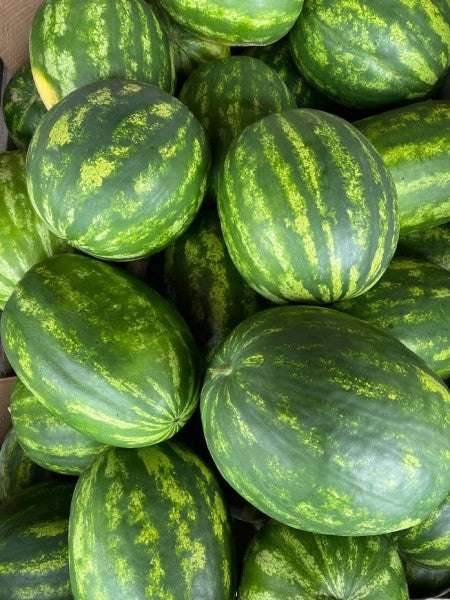
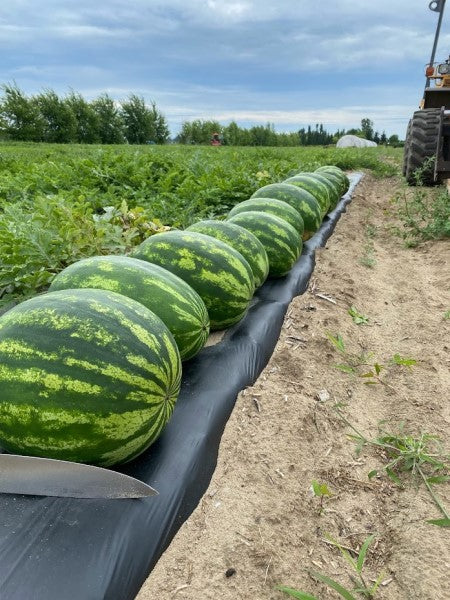
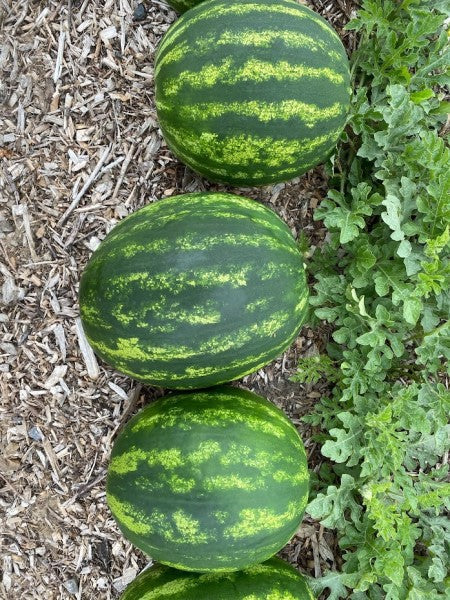
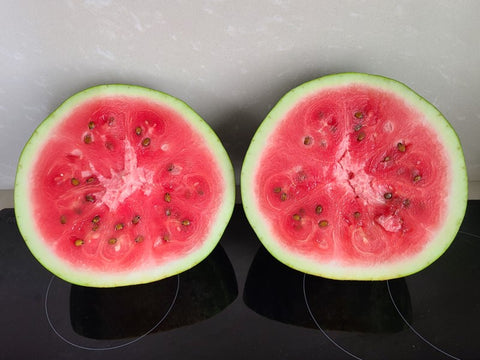
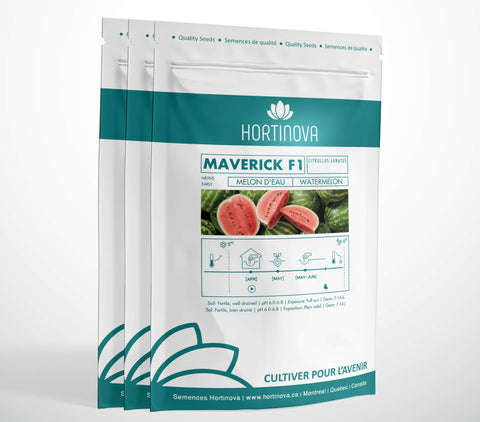
Hortinova
MAVERICK F1 - Hybrid Watermelon Seeds
Citrullus lanatus
- Early maturity.
- Crimson Sweet type watermelon.
- Diploid variety.
- Fruit size up to 14 kg.
- Round shaped fruit.
- Smooth skin.
- Attractive striped shiny outer skin.
- Bright red firm flesh.
- High brix.
- Crisp texture.
- Resistance to CMV, F1, F2, Anthracnose.
- Hybrid seeds.
- Natural, Untreated, Non-GMO Seeds.
For early and reliable crops, sow seeds indoors just after the last spring frost. Plan to transplant seedlings into the garden about 2 weeks after that date or when the soil has warmed to at least 65°F (18°C). In warmer climates with long growing seasons, sow seeds directly outdoors 1 to 2 weeks after your last frost date, as long as the soil temperature has warmed to at least 65°F (18°C). Sow seeds 1/2 to 1 inch deep outdoors or 1/4 to 1/2 inch deep in seed-starting pots indoors. To allow for more root growth, use larger starting pots than you would for most seeds. Also consider using compostable pots that can be cut away or planted directly in the garden, as this will minimize the risk of damaging seedlings’ tender roots during transplanting. If direct seeding outdoors, sow 4 to 6 seeds per hill, eventually thinning to 2 to 3 seedlings.
PLANT OUT: Handle watermelon seedlings with extreme care when you transplant. Their roots are very fragile, so try not to disturb the soil when removing them from pots. Transplant to the field only after the danger of frost has passed and midmorning soil temperatures are regularly at least 65°F (18°C) at a depth of 4 inches. Cooler soil temperatures will delay growth. The seedlings should be spaced 18–24 inches apart with rows 6 feet apart. Watermelons do best in loamy, somewhat-sandy, well-drained soil. They can struggle in soil that contains too much clay and doesn’t drain well. Watermelons need a lot of space—up to 20 square feet per plant. Their vines need room to sprawl, so plant them in a place where they won’t crowd out other crops. Growing the vines in raised rows ensures good drainage.
EXPOSURE: Watermelons require full sunlight in order to thrive. The plants can tolerate some partial shade, particularly in hotter climates, but plenty of sun is necessary to develop the sugars in the melons. Excessively shady conditions will reduce the number and size of the fruits.
WATER: Watering is very important—from planting until fruit begins to form. When transplanting, water with a high phosphorous transplant fertilizer. While watermelon plants are growing, blooming, and setting fruit, they need 1 to 2 inches of water per week. Keep soil moist, but not waterlogged. Water at the vine’s base in the morning and try to avoid wetting the leaves and avoid overhead watering. Reduce watering once fruit are growing. Dry weather produces the sweetest watermelon.
FEED: Amend soil with aged manure, seaweed, and/or compost before planting. Watermelons are heavy feeders, meaning they need soil that is fertile and has a high nutrient level. When fertilizing, make sure to deliver more nitrogen than phosphorus and potassium, as this will encourage leaf and vine growth. However, after flowering begins, use a fertilizer with less nitrogen to instead encourage flowers and fruit.
PROTECT: Mulching with black plastic or straw around the plants will serve multiple purposes: it will warm the soil, hinder weed growth, and keep developing fruits off the soil. After transplanting, cover the plants with row covers to keep pests at bay. Remember to remove the row covers when you see both male and female flowers on the vine, as pollinators will need to access the flowers. As fruit is ripening, prevent rotting by gently lifting it and putting cardboard or straw between the fruit and the soil.
PRUNING: Pruning generally isn’t necessary for watermelon plants, but vine productivity may be improved if you do not allow lateral vines to grow and stick to the main vine. When the plant is young, just cut off the end buds as they form (before the side shoots become vines).
Watermelons don’t continue ripening after they are picked, so harvest time is important. They generally ripen over a two-week period, so keep your eye on them. Thump it. If the watermelon sounds hollow, it’s ripe. Look at the color on the top. The watermelon is ripe when there is little contrast between the stripes. Look at the color on the bottom. An immature watermelon will have a white bottom; a ripe melon will have a cream- or yellow-colored bottom. Stems should be cut with a sharp knife close to the fruit.
Gros calibres avec une superbe uniformité dans les fruits. Goût et texture excellente pour un melon hâtif. Rendement exceptionnel avec une superbe couverture foliaire au champs.
Let customers speak for us
from 23 reviewsWe grow several varieties of various colours of tomatoes, and the contrast of these tomatoes with other colours is fantastic. We've had a very long season with our plants, excellent disease resistance, great flavour.

This review applies to all of the seeds I purchased from Hortinova - beautiful tomatoes, good disease resistance and excellent production. Our field season extended to 10 weeks. We've had comments of excellent flavour from our customers as well, highly recommend any Hortinova seed.

This tomato is good taste tomato. Small red round tomato. Bigger then cherry tomatoes but smaller then regular one. I like it. Perfect for salads and fresh eating. Ordered seeds for next season.

2nd time ordering. Very satisfied with qualify and result. Thank you

BALCONY YELLOW F1 - Hybrid Cherry Tomato Seeds

Delivered very fast, packed very good, in professional condition and quality. Thanks

DUETT - Open Pollinated Radish Seeds

We will see what they are like this summer.

Type crimson de bonne grosseur avec une superbe uniformité et très hâtif. Un des premiers prêt en saison. Semences très petites et peu nombreuses. Goût très sucré et chaire croquante. Chair passant du rose au rouge en cours de saison. Les plants sont forts et très vigoureux avec des grosses feuilles.

Vigueur des plants impressionante avec des fruits résistants aux fissures et aux dommages. Très bonne conservartion et goût très sucré lorsque les nervures deviennent orange. Peu être récolté lorsque les nervures sont vertes également. Cavité des semences très compacte et petite laissant beaucoup de chair.

Melon qui fond en boûche avec un goût se rapprochant du melon miel et du cantaloup à la fois, très sucré. Faire attention aux irriguations lorsque le melon devient mature car il peut fendre au champs. Très odorant.

Avec son apparence côtellée, son très gros calibre et ça couleur rose, cette tomate se démarque des autres sur les tablettes. Variété plus résistante à la pourriture apicale que la plus part des autres tomates roses. Bon ensemble de résitance aux maladies également.

Tomate noire dont les faces qui ne sont pas exposé au soleil passent du vert au rouge lorsque mature donnant un aspect unique aux fruits. Charactéristiques similaires à la Barrio avec un goût superbe sans acide. Les clients l'on adoré.

Superbe adaptabilité et excellente résistance aux maladies. Fruits uniformes qui ne fendent pas, bonne conservation. Ajoutez à cela un goût unique avec une légère acidité et une pointe sucré.















